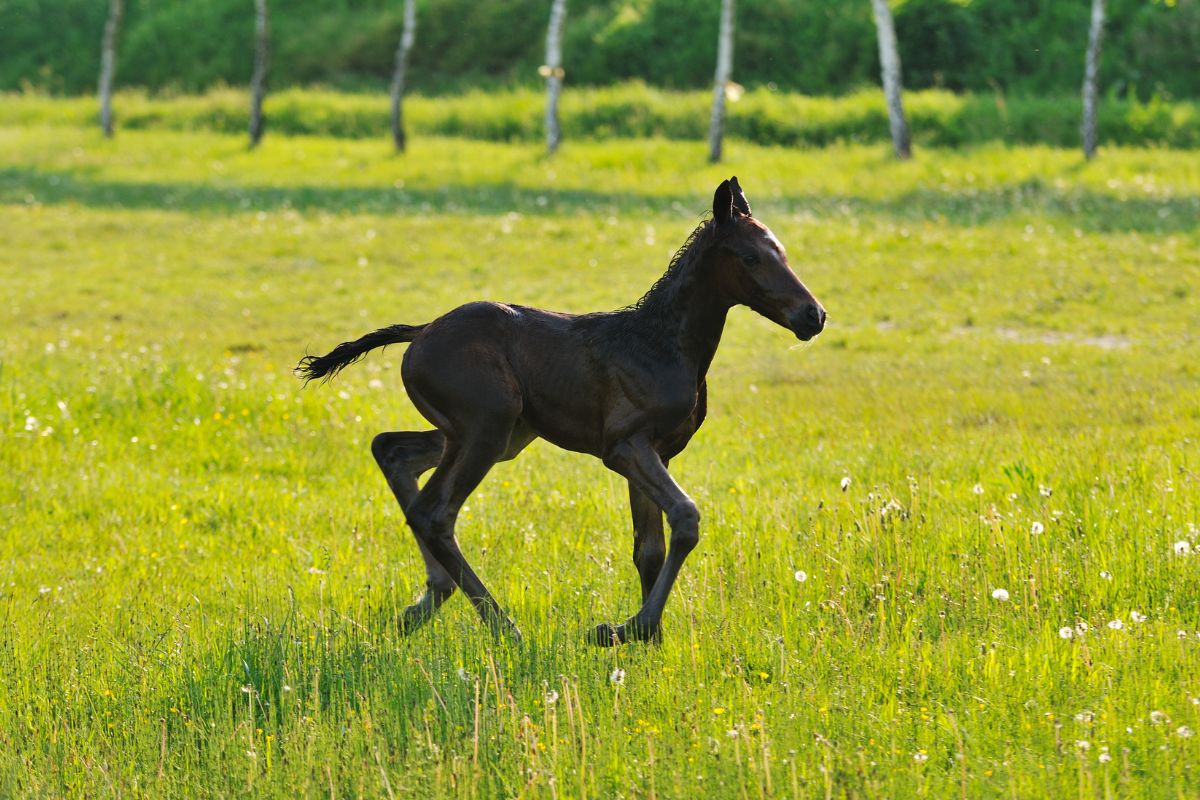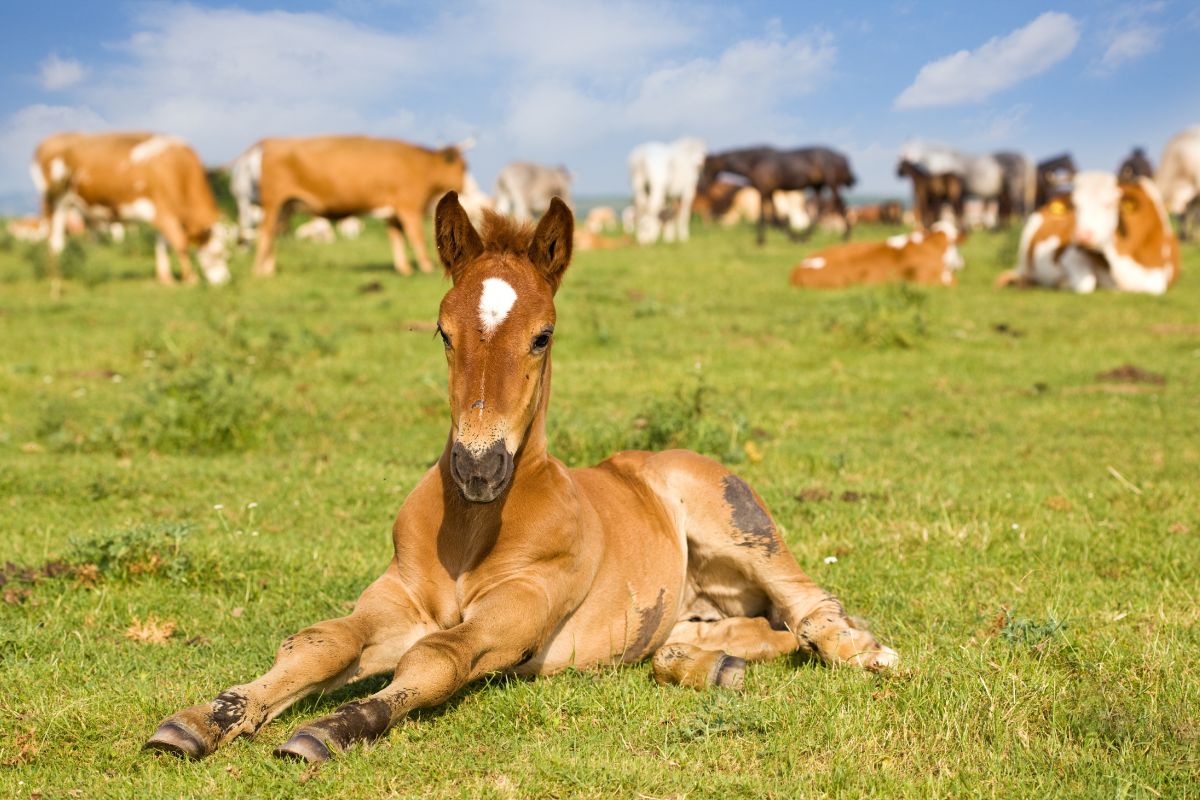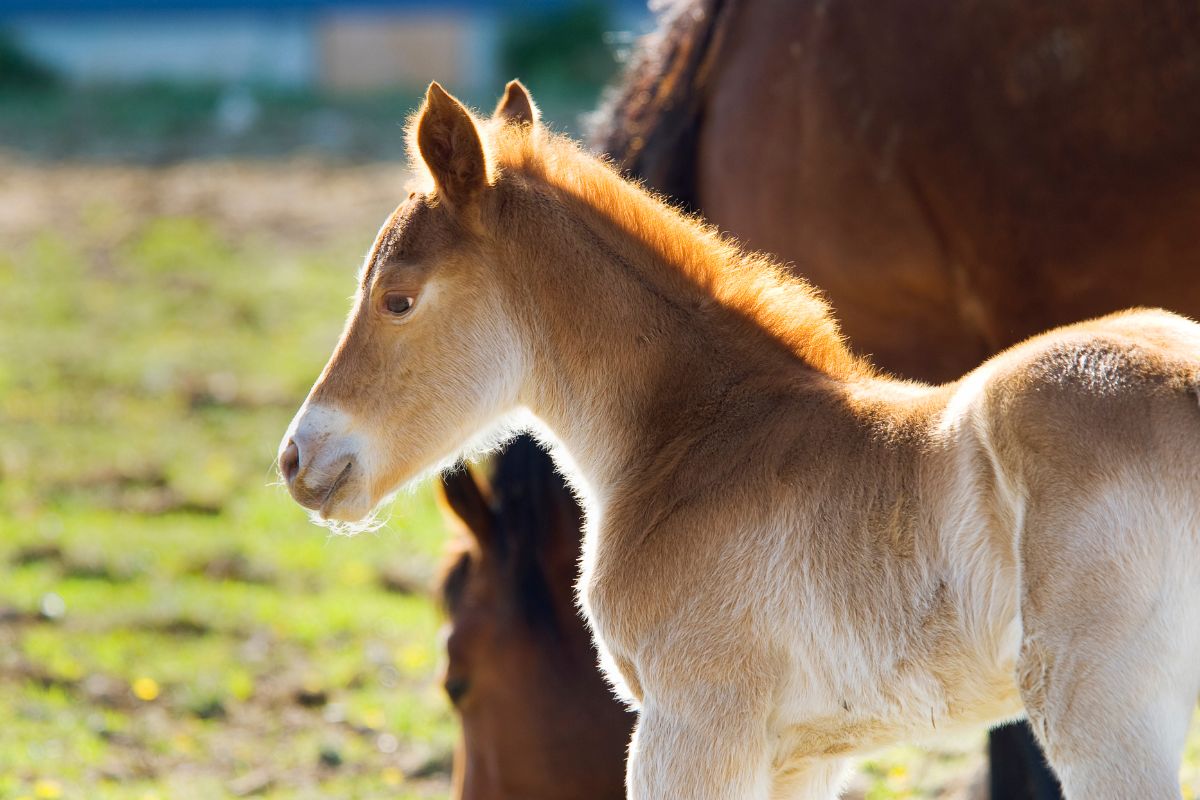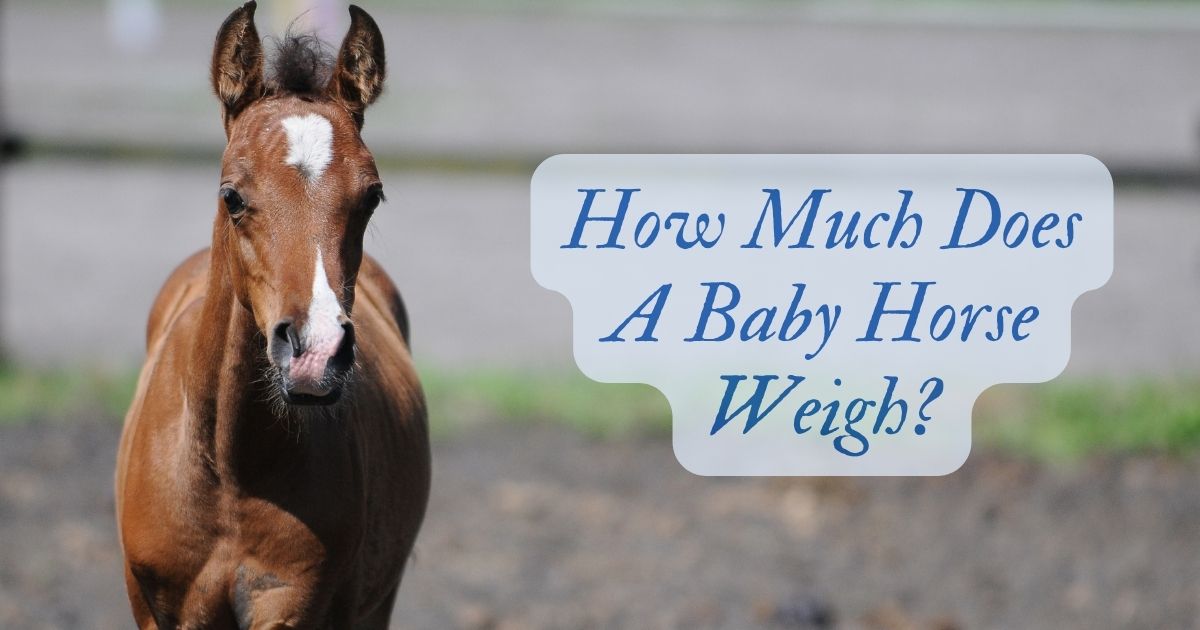Do you always wonder how much does a baby horse weigh? This is the question on many minds across the globe, and we have the answer. The average-sized mare can give birth to a foal that weighs about 10% of the mare’s weight, which amounts to approximately 100 pounds (45 kilograms). But what determines how much a baby horse will weigh when born?
We want to help you learn about these adorable creatures – their weight, diet, and more. So keep reading to learn everything you need about baby horses!

What is a New Born Horse Called?
All baby animals have names, and most creatures only receive two throughout their life to symbolize their youth and adulthood. Horses are different, though, as they go by many names depending on their stage of development. This often leaves people wondering: “What do you call a baby horse?”
- Male and female horses younger than twelve months old are both commonly referred to as foals.
- Baby horses are also called weanlings. Weaning is when a horse stops suckling, usually around four months old. Most weanlings follow the traditional horse-weaning diet.
- Some people refer to baby horses as yearlings. A yearling is an aged horse one to two years old. It is weaned and no longer needs milk from its mother; now, it feeds on pasture or hay.
- As the young horses grow up and their gender becomes clear, you can start referring to them by male or female names.
- A colt is a name for a baby male horse until he reaches four years old, after which he may be called a stallion or gelding, depending on his ability to reproduce.
- A filly is a baby female horse, and like males, a filly is young until she reaches the age of four years old.
Equine Birth Factors That Determine Size
It is difficult to predict how much a baby horse will weigh when born. This is because several factors influence the baby horse’s size and weight.
First, the baby horse’s breed will impact its size and weight. Some breeds are naturally bigger than others, so baby horses from larger breeds will weigh more at birth than baby horses from smaller breeds.
Secondly, the baby horse’s sex can also influence its size and weight. Generally, baby male horses will weigh more than baby female horses due to their larger body size.
Finally, the baby horse’s nutrition and health will also play a role in its size and weight at birth. Baby horses that are well-nourished and healthy will weigh more than baby horses that are malnourished or unhealthy.
On average, baby horses weigh anywhere from 100 to 200 pounds (45 to 90 kilograms) when born. However, baby horses can weigh more or less depending on the above factors. It is important to remember that baby horses will continue to gain weight and grow as they age.
Why Does the Mare Have to Disspell the Placenta?
After a baby horse is born, the mare (mother horse) needs to expel the placenta for the baby horse to stay healthy. The placenta is the organ that nourishes the baby horse before birth, and it needs to be expelled for the foal horse to start receiving nutrients from its mother.
Additionally, the baby horse needs this expelled placenta to establish its blood type, which is important for vaccinations. The mare needs to expel the placenta within an hour of giving birth to not expose the baby horse to possible infection.
If the mare does not expel the placenta, the baby horse’s health and well-being could be at risk. Therefore, it is important to ensure that the horse baby gets the nutrients it needs and that the mare expels the placenta. This will ensure that baby horses start on the right hoof!
Twin and Low Birth Weight Foals
Baby horses can also sometimes be born underweight or as twins.
It is usually premature if a foal horse weighs less than 10 percent of its mother’s weight. Within two hours, most normal foals can stand and nurse. Usually, premature foals have difficulty standing. If you are still determining when the conception occurred, several indicators will show whether the low-birth-weight baby horse is premature.
If your mare gives birth to a foal with the following characteristics — silky hair, floppy ears, tendon weakness, or domed forehead — then immediately call your veterinarian. The difference in potential survival for low-birth-weight foals is substantial, depending on whether they are considered premature.
In the equine world, twin deliveries are rare. If a mare gets an ultrasound early in pregnancy and twin embryos are detected, your vet can “pinch” one so that only one healthy foal will be born.
A mare’s uterus can successfully carry only one foal; therefore, those carrying twins often experience late-term abortions. If both fetuses make it to the delivery, their chances of survival are low because of their low birth weights. In rare cases, one fetus might live while the other twin dies soon after birth. It is almost impossible for both twins to survive and be healthy.
Monitoring a baby horse’s weight on a regular basis is crucial as even a small change can signal a health problem. To ensure baby horses get the nourishment they need, owners should pay close attention to their baby horse’s diet and provide adequate amounts of hay and grain as needed. This will help baby horses to reach their full potential and stay healthy!

Normal Foal Birth Weight
A baby horse’s birth weight will always be approximately 10 percent of its mother’s weight no matter the breed.
For example, a 1,000-pound (453.59 kilograms) thoroughbred mare has a 100-pound (45 kilograms) foal, while a 1,500 pounds (680.38 kilograms) warmblood mare gives birth to 150 pounds (68.03 kilograms) and the 2,000 pounds (907.18 kilograms) draft mare births 200 pounds (90.71 kilograms).
These proportional weights will remain consistent whether the mare is a breed of a large or small stallion.
How to Calculate a Foal’s Birth Weight
Knowing the foal’s weight can benefit baby horses and their owners. To calculate a baby horse’s birth weight, multiply the mare’s weight by 0.1. For example, if a 1,000 pounds (453.59 kilograms) mare gives birth to a baby horse, it will weigh about 100 pounds (45 kilograms).
Knowing the baby horse’s weight is important for monitoring the baby horse’s health and growth, so be sure to weigh baby horses often after birth. Weighing baby horses will ensure they are healthy and get the necessary nourishment!
Can a Foal Grow Too Fast?
Horses grow relatively quickly, and genes determine this rate. If a foal does not consume enough food, its growth may stunt or stop entirely.
If you feed a foal adequately, it will grow as its genetic code dictates and be a healthy adult. Overfeeding or feeding supplements that spur abnormal growth can cause issues like arthritis or heart disease later.
When a foal grows too quickly, it can damage its health. It might experience bone development problems or joint pain. A rapidly growing horse foal needs more calories than usual. You may need to feed the horse an extra pound (kilogram) of grain daily or provide additional hay.
A foal can also become overgrown if it is fed too much or does not get enough exercise. The best way to prevent this is by feeding the proper amount of food and providing adequate exercise.
How Much Should a Two-Month-Old Horse Weigh?
A 2-month-old horse usually weighs between 300 and 500 pounds (136.07 and 226.79 kilograms). On average, horses grow at a rate of 1 pound (0.45 kilogram) per day until they are five years old. In the first two months, however, foals often grow more than twice their birth weight.
Generally, you can estimate a horse’s weight by height and bone density. They grow to maturity at an age-appropriate rate, reaching their full size when they turn 5.
How Important is Mare’s Milk for a Foal’s Growth?
Mare’s milk is a source of nutrition for foals and contains the essential nutrients they need for growth and development. This includes minerals, vitamins, proteins, calcium, and phosphorus – all crucial to a young horse’s immune system functioning properly and their brain and muscle growth.
It can also reduce newborn foal gastrointestinal issues, improve immunity to diseases, and stimulate healthy gut function.
A foal’s health depends on the quality of the mare’s milk and how much access the mother has to quality and nutritious feed. If a lack of nutritious food sources exists, she won’t be able to produce rich milk for her baby horse. Mare’s milk contains vital nutrients essential for a foal’s growth; without it, it will struggle to develop properly.
FAQS
Can You Ride a Baby Horse?
No, it would be best if you did not ride a horse younger than four. Their bones are still growing at this age, and they could easily get injured if someone were to ride them.
You should only weigh your horse heavily after first checking with a veterinarian. They will be able to let you know if the horse’s body is ready to support that weight by examining the growth plates in its knees.
Depending on numerous factors, such as its breed, the average horse will be ready to ride at around four years old. However, some may take longer to develop physically and become ridable.
For example, Quarter Horses are frequently fully developed for riding as yearlings and will be able to handle strenuous training by the time they’re two years old. Thoroughbreds follow a similar timeline in terms of readiness for training.
On the other hand, the Shire and Clydesdale breeds will be entirely grown and developed to ride by the time they are four or five years old.
Another common roadblock to your horse’s growth is poor health. If the illness has been a frequent visitor in your horse’s life, full development will probably take longer than average, which may mean you have to postpone riding or training for a few more years.
What is Gelding?
Gelding is when you castrate a male horse to make it more docile and easy to work with. Afterward, the horse is called a gelding.
If you do not geld a male horse, it is still a stallion and may maintain its aggressive stallion demeanor. You should always castrate male horses unless you want to use them for breeding in the future.
When are Male Baby Horses Gelded?
The ideal time to geld a colt is before the horse reaches the age of a year. The sooner you geld your colt, the less likely the horse will develop stallion-like behaviors.
The testicles produce testosterone, which triggers physical attributes like those seen in stallions. An overabundance of this hormone causes aggression in horses, which could pose a danger to handlers and other animals.
Geldings are often called gentleman’s horses. They offer many benefits to the rider. Because they don’t have testosterone running through their veins, geldings can focus more on the task than stallions.
This usually leads to more successful results in competitions. Geldings also tend to be calmer horses overall, which makes them perfect for beginner riders who are new to horseback riding altogether. Simply put, they’re just safer horses for inexperienced people.
Not only will gelding your horse results in a calmer, more well-rounded animal, but it also helps avoid unwanted breeding due to male horses’ lack of interest in female horses.
What is the Name of a Horse’s Mother?
Many people believe that a foal’s mother is called a mare. However, this is incorrect. The female equine is called a dam, and only if its usage is for reproduction does her title change to broodmare.
A mare can have several foals throughout its lifetime, with some healthy ones able to produce up to sixteen. However, if a mare wants to have that many offspring, it must start breeding when its four years old and remain fertile until at least twenty.
When is A Baby Horse Weaned?
When you wean a horse, you’re slowly transitioning it from its mother’s milk to an adult equine diet. When the best time to do this is up for debate, some recommend doing it after the second month, others say the fourth month, and some wait until nine months old.
So, you might wonder when the best time to wean a baby horse is. You can do so safely after the third month. By this point, the horse is probably eating enough grass to maintain a healthy diet.
With the added nutrition, weaning the youngling will be healthier for both baby and mother. The foal won’t need to suckle as much, giving the mother a chance to regain her strength.
However, some experts argue that weaning baby horses at three months puts them at a higher risk of developing behavior problems and makes them susceptible to orthopedic diseases.
A veterinarian can help determine the best time to wean your baby horse. If you wean a foal too early, it may have more health problems. The vet will also be able to suggest ways to make the process easier on the foal, like letting them socialize with other horses their age.
How Much Does a Newborn Horse Weigh?
When born, the average baby horse, or foal, weighs between 100 and 200 pounds (45 and 90 kilograms). Intelligent horse breeds, such as Arabian horses, usually weigh closer to the lower end of that estimate, while draft breeds, like Clydesdales, will weigh more at birth.

The Word’s Out!
Now that you know baby horses can weigh anywhere from 100 to 200 pounds (45 to 90 kilograms) at birth and are usually weaned after three months; you can now know to take better care of your baby horse.
By understanding your baby horse’s weight, nutrition, and other aspects of equine health, you can ensure that your baby horse grows up healthy and strong. With the right care and attention, baby horses develop into stunning adults that bring joy to anyone who watches them.
So go ahead and share your newfound knowledge of baby horse weight with those around you!
